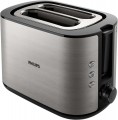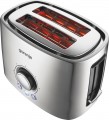Power
Electrical power consumed by the device during operation. A more
powerful appliance spends less time cooking to readiness; at the same time, the high consumption of electricity is often offset by the speed of cooking (in other words, the device simply does not have time to "eat" a lot of energy). However, such a device will also cost more. Therefore, it makes sense to specifically look for such a technique mainly in cases where “every extra second matters” — for example, if a toaster is bought for a cafe or diner where you need to cook quickly and in large quantities.
Also note that a device with a large capacity will inevitably require a higher power.
Roasting degree
The number of roasting levels provided in the device.
This parameter is relevant primarily for models with step adjustment (see "Control"). Each degree of roasting corresponds to a certain fixed power setting in them. Accordingly, the more such steps, the more options the user has, the more accurately he can set the preparing mode. At the same time, we note that even for an advanced model, 8 – 9 steps are considered quite sufficient, a larger number is extremely rare. And for simple household use, more than 5 – 6 steps are rarely required — unless you plan to cook according to specific recipes.
Note that the number of degrees of roasting can also be indicated for equipment with smooth adjustment. However, these are not fixed settings, but only auxiliary divisions on the adjustment scale; they are applied in order to make it easier to navigate for the user. So you can not pay much attention to this moment when choosing a device with smooth adjustment.
Material
The main material used in the body of the device.
—
Plastic. Plastic is an affordable and practical material that offers functionality in various applications. Its lightweight nature makes it suitable for complex shapes, and it can be easily colored to match any desired aesthetic. Additionally, plastic's low thermal conductivity helps conserve energy and reduces the risk of burns from touching the device's exterior. While plastic may not match the strength and scratch resistance of metal, these aspects primarily impact the device's appearance rather than its critical functionality. One significant drawback is plastic's limited heat resistance, which necessitates additional thermal insulation and makes it less reliable in case of malfunctions. Plastic is found across different price ranges, but it is particularly popular in relatively inexpensive devices.
—
Steel. Steel cases are known for their exceptional strength and reliability, surpassing plastic cases in scratch resistance and ability to withstand high temperatures. The solid appearance of steel adds to its appeal. However, steel is considerably more expensive, making all-metal cases more commonly found in mid-range and high-end devices. In budget-friendly devices, steel is often used as an additional decorative coating on top of plastic or only in specific areas of the case, typically near the heating element where enhanced durabil
...ity is required.
— Glass. When it comes to kitchen appliances, it is impractical to construct the entire case out of glass. Instead, glass is typically used for separate parts, often the front and back panels, while the rest of the body is made of metal and/or plastic. Glass inserts provide a unique aesthetic appeal, allowing a glimpse of the device's internal components without the need to open the case. However, this design is expensive and lacks practical advantages compared to more traditional materials. Even tempered and heat-resistant glass remains fragile. As a result, such cases are extremely rare and usually found in designer models.
